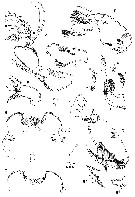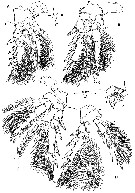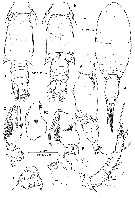|
|
 |
|
Cyclopoida ( Order ) |
|
|
|
Oncaeidae ( Family ) |
|
|
|
Oncaea ( Genus ) |
|
|
| |
Oncaea serrulata Böttger-Schnack, 2011 (F,M) | |
| | | | | | | Syn.: | Oncaea sp.7 Böttger-Schnack, 1997 (p.414, Table 10) | | | | Ref.: | | | Böttger-Schnack, 2011 (p.327, figs.F,M) |  issued from : R. Böttger-Schnack in Mar. Biodiv., 2011, 41. [p.329, Fig.1]. Female (Mediterranean Sea): A-B, habitus (dorsal and lateral, respectively; appendages omitted); C-D, urosome (dorsal and lateral, respectively); E, genital double-somite and posterior part of P5-bearing somite (ventral), showing surface ornamentation on genital double-somite and midventral spinous processes on P5-bearing somite; F, caudal ramus (dorsal; individual elements numbered using Roman numerals); G, A1; H, P5 exopod (dorsal view); tip of ventral and dorsal seta enlarged, showing terminal pore.
|
 issued from : R. Böttger-Schnack in Mar. Biodiv., 2011, 41. [p.331, Fig.2]. Female: A, A2 (posterior), coxobasis slightly damaged, lateral elements on distal endopod segment numbered using Roman numerals, distal elements identified by capital letters [a coxobasis, anterior, showing surface ornamentation]; B, labrum (anterior); C, same (poserior); D, Md, showing individual elements, xhich are identified by capital letters; E, Mx1 (subapical pore on outmost element of inner lobe and apical pore on innermost element of outer lobe arrowed); F, Mx2 (elements figured separately); G, Mxp (anterior), syncoxa slightly damages [g1 proximal part of distal endopod segment (claw), posterior showing accessory elements; g2 palmar margin (posterior), showing elements].
|
 issued from : R. Böttger-Schnack in Mar. Biodiv., 2011, 41. [p.333, Fig.3]. Female: A, P1 (posterior), arrow indicating vestigial inner coxal seta [a : inner part of coxa and basis (anterior), vestigial inner coxal seta arrowed]; B, P2 (posterior), conical process on distal endopod segment figured separately; C, P3 (anterior); D, P4 (anterior), intercoxal sclerite missing, arrow indicating vestigial inner coxal seta [d: coxa, basis, and part of intercoxal sclerite (posterior), vestigial inner coxal seta arrowed].
|
 issued from : R. Böttger-Schnack in Mar. Biodiv., 2011, 41. [p.334, Table 1]. Female & Male: Armature of swimming legs. Spines = Roman numerals; Setae = Arabic numerals; + = vestigial naked seta present.
|
 issued from : R. Böttger-Schnack in Mar. Biodiv., 2011, 41. [p.335, Fig.4]. Male: A, habitus (dorsal); B, Mxp (anterior [b1 syncoxa (posterior) showing surface ornamentation; b2 basis (anterior face) showing ornamentation along outer spinous margin]; C, same ( (medial view); D, urosome (dorsal), spermatophore immature; cross indicating insertion scar of missing seta III; E, urosome (ventral), cross indicating insertion scar of missing seta III; F, same (lateral), cross indicating insertion scar of missing seta III; G, A1; H, P4, coxa and basis (posterior), question mark indicating potential position of vestigial inner coxal seta not discerned (but see female, fig. 3 D, d).
| | | | | NZ: | 1 | | |
|
Distribution map of Oncaea serrulata by geographical zones
|
| | | | | | | Loc: | | | Medit. (Balearic Basin, Ligurian Sea, Strait between Tunisia and Sicily, S Crete) | | | | N: | 1 | | | | Lg.: | | | (1075) F: 0.528-0.574; M: 0.420-0.510; {F: 0.528-0.574; M: 0.420-0.510} | | | | Rem.: | meso-bathypelagic.
For Böttger-Schnack (2011, p.325) this species differs from Oncaea notopus, but belongs to the notopus-group whhich are characterized by a long, free exopod on P5. It differs from O. notopus and any other described species of this group by: 1- the relative lengths of distal endopod spines on P2 and P3; 2- the denticulate ornamentation of the exopod segment and the two exopodal setae on P5; 3- the proportional lengths of the caudal setae; 4- the comparatively small body length.
The species occurs widespread in the Mediterranean Sea (mesopelagic and deep-sea layers down to 3000 m depth , and was found in near-bottom sediment traps in the Ligurian Sea). For Böttger-Schnack O. serrulata appears to be the only representative of the notopus-group in the Mediterranean Sea and seems to havebeen confounded with O. notopus Giesbrecht, 1891 originally described from the Pacific. | | | Last update : 27/01/2015 | |
|
|
 Any use of this site for a publication will be mentioned with the following reference : Any use of this site for a publication will be mentioned with the following reference :
Razouls C., Desreumaux N., Kouwenberg J. and de Bovée F., 2005-2025. - Biodiversity of Marine Planktonic Copepods (morphology, geographical distribution and biological data). Sorbonne University, CNRS. Available at http://copepodes.obs-banyuls.fr/en [Accessed January 01, 2026] © copyright 2005-2025 Sorbonne University, CNRS
|
|
 |
 |







